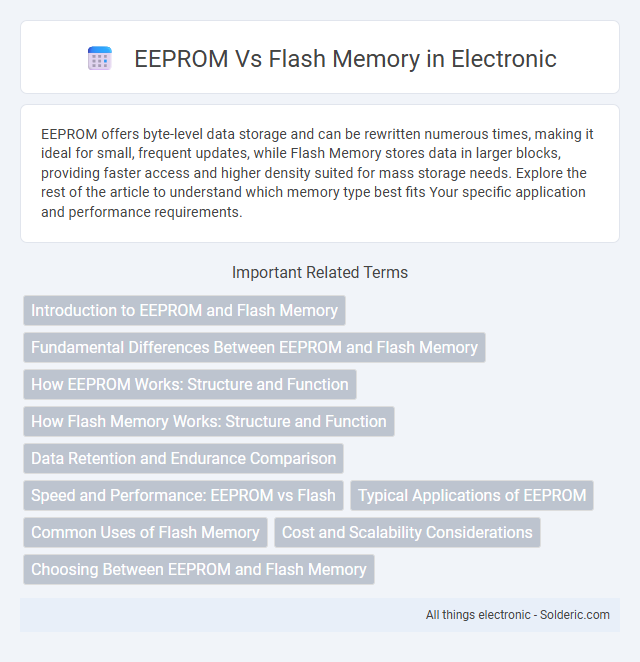EEPROM offers byte-level data storage and can be rewritten numerous times, making it ideal for small, frequent updates, while Flash Memory stores data in larger blocks, providing faster access and higher density suited for mass storage needs. Explore the rest of the article to understand which memory type best fits Your specific application and performance requirements.
Comparison Table
| Aspect | EEPROM | Flash Memory |
|---|---|---|
| Storage Type | Non-volatile memory with byte-level access | Non-volatile memory with block-level access |
| Write/Erase Granularity | Byte or word | Block or sector (typically 64KB) |
| Erase Time | Slow (milliseconds per byte) | Faster (milliseconds per block) |
| Write Cycles Endurance | High (~1 million cycles) | Moderate (~10,000 to 100,000 cycles) |
| Typical Use Case | Storing small amounts of data, configuration settings | Mass storage, firmware, large data blocks |
| Cost | Higher cost per bit | Lower cost per bit |
| Access Speed | Slower compared to flash | Faster read/write speeds |
| Data Retention | Typically 10-20 years | Typically 10 years |
Introduction to EEPROM and Flash Memory
EEPROM (Electrically Erasable Programmable Read-Only Memory) and Flash Memory are non-volatile storage technologies used in electronic devices to retain data without power. EEPROM allows byte-level data erasure and rewriting, making it ideal for applications requiring frequent updates, while Flash Memory erases and writes data in larger blocks, offering faster performance and higher storage capacity. Understanding the key differences in their architecture helps you choose the right memory type for embedded systems, firmware storage, or data logging needs.
Fundamental Differences Between EEPROM and Flash Memory
EEPROM stores data byte-by-byte, enabling precise and frequent rewrites, which makes it ideal for small data updates, while Flash memory erases and writes data in large blocks, providing faster performance and higher density storage. EEPROM typically offers longer write endurance with up to 1 million write cycles, whereas Flash memory, especially NAND Flash, ranges from 10,000 to 100,000 write cycles but excels in cost-effective mass storage. The fundamental difference lies in their architecture; EEPROM uses floating-gate transistors for individual byte manipulation, whereas Flash memory organizes data into sectors that require block-level erasure and rewriting.
How EEPROM Works: Structure and Function
EEPROM (Electrically Erasable Programmable Read-Only Memory) operates using a floating-gate transistor structure that stores electrical charges to represent data bits. Each cell consists of a MOSFET with an insulated gate, where applying a higher voltage causes electrons to tunnel through the oxide layer, altering the charge state and thus the stored information. This cell-level charge manipulation enables byte-level erasure and reprogramming, distinguishing EEPROM from Flash memory, which erases in larger blocks.
How Flash Memory Works: Structure and Function
Flash memory stores data using an array of memory cells made from floating-gate transistors, which trap electrons to represent binary information. It operates by erasing data in blocks or sectors before new data can be written, enabling high-density storage and fast access times. Your device relies on this structure for efficient, non-volatile storage that retains information without power.
Data Retention and Endurance Comparison
EEPROM offers superior data retention and endurance, typically sustaining over 1 million write/erase cycles with data retention exceeding 20 years, making it ideal for applications requiring frequent updates and long-term reliability. Flash memory, while cost-effective and faster in bulk operations, generally supports around 10,000 to 100,000 write/erase cycles with data retention spanning 10 to 15 years, which may limit its use in high-endurance scenarios. Understanding your specific data retention and endurance needs is essential to selecting the appropriate non-volatile memory technology for optimal performance and longevity.
Speed and Performance: EEPROM vs Flash
EEPROM typically offers slower write and erase speeds compared to Flash memory, with write cycles measured in milliseconds versus microseconds for Flash. Flash memory supports faster block-level erase and write operations, making it more suitable for high-speed data storage applications. However, EEPROM provides finer byte-level write control, beneficial for applications requiring frequent, small data updates without erasing entire blocks.
Typical Applications of EEPROM
EEPROM is widely used in microcontrollers, BIOS chips, and small-scale data storage applications requiring frequent, low-volume writes with byte-level access. It excels in storing configuration settings, calibration data, and device identification information due to its non-volatile nature and endurance for repeated write cycles. Unlike Flash memory, EEPROM allows precise data modification without erasing entire blocks, making it ideal for embedded systems and firmware storage.
Common Uses of Flash Memory
Flash memory is widely used in smartphones, USB drives, solid-state drives (SSDs), and memory cards due to its fast read speeds and high storage capacity. It offers non-volatile storage ideal for operating systems, applications, and media files, making it a staple in consumer electronics and embedded systems. Your devices rely on flash memory for efficient data storage and quick access during daily operations.
Cost and Scalability Considerations
EEPROM typically incurs higher per-bit costs than flash memory due to its byte-level erase and write capabilities, making it less scalable for large storage applications. Flash memory offers significant cost advantages for mass storage as it erases data in large blocks, enabling higher density and lower manufacturing expenses. When optimizing your project for cost and scalability, flash memory is generally preferred for extensive data storage requirements, while EEPROM suits smaller, specialized tasks.
Choosing Between EEPROM and Flash Memory
Choosing between EEPROM and flash memory depends on the application's requirements for data retention, write cycles, and storage capacity; EEPROM offers byte-level erasure and rewriting with higher endurance, ideal for storing small amounts of data like configuration settings. Flash memory provides larger storage density and faster write/erase operations but operates on block-level erasures, making it suitable for firmware updates and mass data storage. Cost considerations and power consumption also play critical roles, as EEPROM typically has higher per-bit cost and lower power efficiency than flash memory.
EEPROM vs Flash Memory Infographic

 solderic.com
solderic.com